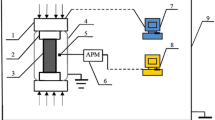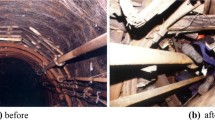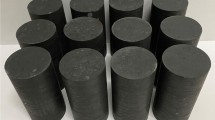Abstract
Coal rock would emit the electromagnetic radiation (EMR) while deformation and fracture, and there exists structural body in the coal rock because of mining and geological structure. In this paper, we conducted an experimental test the EMR characteristics of cracked rock under loading. Results show that crack appears firstly in the prefabricated crack tip then grows stably parallel to the maximum principal stress, and the coal rock buckling failure is caused by the wing crack tension. Besides, the compressive strength significantly decreases because of the precrack, and the compressive strength increases with the crack angle. Intact rock EMR increases with the loading, and the cracked rock EMR shows stage and fluctuant characteristics. The bigger the angle, the more obvious the stage and fluctuant characteristics, that is EMR becomes richer. While the cracked angle is little, EMR is mainly caused by the electric charge rapid separates because of friction sliding. While the cracked angle is big, there is another significant contribution to EMR, which is caused by the electric dipole transient of crack expansion. Through this, we can know more clear about the crack extends route and the corresponding influence on the EMR characteristic and mechanism, which has important theoretical and practical significance to monitor the coal rock dynamical disasters.















Similar content being viewed by others
References
Abdollahipour A, Marji MF, Bafghi AY (2016) DEM simulation of confining pressure effects on crack opening displacement in hydraulic fracturing. Int J Min Sci Technol 26(4):557–561
Attewell PB, Sandford MR (1974) Intrinsic shear strength of a brittle, anisotropic rock—III: textural interpretation of failure. Int J Rock Mech Min Sci 11(11):431–438
Bandis SC, Lumsden AC, Barton NR (1983) Fundamentals of rock joint deformation. Int J Rock Mech Min Sci Geomech Abstr 20(6):249–268
Chen CH, Chen CS, Wu JH (2007) Fracture toughness analysis on cracked ring disks of anisotropic rock. Rock Mech Rock Eng 41(4):539–562
Cress GO, Brady BT, Rowell GA (1987) Sources of electromagnetic radiation from fracture of rock samples in the laboratory. Geophys Res Lett 14(4):331–334
Dou LM, He XQ, Wang EY (2001) Electromagnetic emission in rock and coal burst failures. J Tsinghua Univ (Sci Technol) 41(12):86–88
Enomotoy, Shimamtot, Tsutumia (1993) Rapid electric charge fluctuation prior to rock fracturing: its potential use for an immediate earthquake precursor. Proceeding so fInter national workshop on electromagnetic phenomena related to earthquake prediction: Terra Scientific Publishing Company, Tokyo, p 64–65
Feng JJ, Wang EY, Li ZH (2016) Investigation on energy dissipation and its mechanism of coal under dynamic loads. Geomech Eng 11(5):657–670
Frid V (1997) Rockburst hazard forecast by electromagnetic radiation excited by rock fracture. Rock Mech Rock Eng 30(4):229–236
Gao Y, Chen X, Hu H (2013) Early electromagnetic waves from earthquake rupturing: II. validation and numerical experiments. Geophys J Int 192(3):1308–1323
Gehle C, Kutter HK (2003) Breakage and shear behavior of intermittent rock joints. Int J Rock Mech Min Sci 40(5):687–700
Hadjicontis V, Mavromatou C (1994) Transient electric signals prior to rock failure under uniaxial compression. Geophys Res Lett 21:1687–1690
Haeri H, Shahriar K, Marji MF (2014) Experimental and numerical study of crack propagation and coalescence in pre-cracked rock-like disks. Int J Rock Mech Min Sci 67(4):20–28
Hain M, Dhopatkar A, Rock P (2003) The effect of ligation method on friction in sliding mechanics. Am J Orthod Dentofacial Orthop 123(4):416
Hao JQ, Liu LQ, Long HL (2004) New result of the experiment on self-potential change of rocks under biaxial compression. Chin J Geophys 47(3):475–482
He XQ, Liu MJ (1995) Fracture electromagnetic dynamics of coal or rock containing gas. China University of Mining and Technology Press, Xuzhou
He XQ, Nie BS, Chen WX (2012) Research progress on electromagnetic radiation in gas-containing coal and rock fracture and its applications. Saf Sci 50(4):728–735
Hsieh YM, Lee KC, Jeng FS (2011) Can tilt tests provide correct insight regarding frictional behavior of sliding rock block under seismic excitation. Eng Geol 122(1):84–92
Hu SB, Wang EY, Liu XF (2014) Spatiotemporal multifractal characteristics of electromagnetic radiation in response to deep coal rock bursts. Nat Hazards Earth Syst Sci Discuss 2(4):2307–2343
Hu QT, Liang YP, Wang H (2017) Intelligent and integrated techniques for coalbed methane (CBM) recovery and reduction of greenhouse gas emission. Environ Sci Pollut Res 24(21):17,651–17,668
Kim DY, Cho BK, Lee SH (2016) Application of Fourier transform-mid infrared reflectance spectroscopy for monitoring Korean traditional rice wine ‘Makgeolli’ fermentation. Sens Actuators B Chem 230:753–760
Kong B, Wang EY, Liang JY (2016a) Experimental study of electromagnetic radiation during coal heating. J China Univ Min Technol 45:205–210
Kong B, Wang EY, Li ZH (2016b) Electromagnetic radiation characteristics and mechanical properties of deformed and fractured sandstone after high temperature treatment. Eng Geol 209:82–92
Kong XG, Wang EY, Hu SB (2016c) Fractal characteristics and acoustic emission of coal containing methane in triaxial compression failure. J Appl Geophys 124:139–147
Li ZH, Wang EY, Liu ZT (2009) Study on characteristics and rules of surface potential during coal fracture. J China Univ Min Technol 38(2):187–192
Li XL, Li ZH, Wang EY (2016a) Analysis of natural mineral earthquake and blast based on Hilbert-Huang transform (HHT). J Appl Geophys 128(5):79–86
Li XL, Li ZH, Wang EY (2016b) Rock burst monitoring by integrated microseismic and electromagnetic radiation methods. Rock Mech Rock Eng 49(11):4393–4406
Li XL, Li ZH, Wang EY (2016c) Extraction of microseismic waveforms characteristics prior to rock burst using Hilbert–Huang transform. Measurement 91(9):101-11
Liang Z, Liu X, Zhang Y (2013) Analysis of precursors prior to rock burst in granite tunnel using acoustic emission and far infrared monitoring. Math Probl Eng 3:1–10
Lippmann H (1990) Mechanical considerations of bumps in coal mines//Fairhurst C. Rockburstsind Seismicity in Mines. Balkema, Rotterdam, pp 279–284
Liu J, Wang EY, Li ZH (2011) Experiment study on surface potential of pre-cracked coal under uniaxial compression. J China Coal Soc 36(7):1135–1138
Lu YY, Ge ZL, Yang F (2017) Progress on the hydraulic measures for grid slotting and fracking to enhance coal seam permeability. Int J Min Sci Technol 27(5):867–871
Ma K, Tang CA, Wang LX (2016) Stability analysis of underground oil storage caverns by an integrated numerical and microseismic monitoring approach. Tunn Undergr Space Technol 54:81–91
Masashi H, Tetsuya I, Natalia S (1999) Fractal analysis of ULF geomagnetic data associated with the guam earthquake on August 8, 1993. Geophys Res Lett 26(18):2797–2800
Ni GH, Cheng WM, Lin BQ (2016) Experimental study on removing water blocking effect (WBE) from two aspects of the pore negative pressure and surfactants. J Nat Gas Sci Eng 31:596–602
Nitsan U (1977) Electromagnetic emission accompanying fracture of quartz-bearing rocks. Geophys Res Lett 4:333–336
Nuka T, Morikawa Y, Norman CP (2011) Use of an infrared monitor to record the frequency and timing of parental nest visitation by the blue rock thrush Monticola solitarius. Zool Stud 50(1):16–23
Padhy S, Panda S (2017) A hybrid stochastic fractal search and pattern search technique based cascade PI-PD controller for automatic generation control of multi-source power systems in presence of plug in electric vehicles. CAAI Trans Intell Technol 2(1):12–25
Pan YS, Tang Z, Li ZH (2013) Research on the charge inducing regularity of coal rock at different loading rate in uniaxial compression tests. Chin J Geophys 56(3):1043–1048
Qiu LM, Wang EY, Song DZ (2017) Measurement of the stress field of a tunnel through its rock EMR. J Geophys Eng 14:949–959
Ren XK, Wang EY, Li ZH (2016) Experimental study of characteristics of surface potential and electromagnetic radiation of pre-cracked rock plate during fracture. J China Univ Min Technol 45(3):440–446
Salvoni M, Dight PM (2016) Rock damage assessment in a large unstable slope from microseismic monitoring-MMG Century mine (Queensland, Australia) case study. Eng Geol 210:45–56
Song XY, Li ZH, Wang EY (2016) Charging characteristics of the crack propagation of rock under load. J China Coal Soc 41(8):1941–1945
Takeuchi A, Lau BWS, Freund FT (2006) Current and surface potential induced by stress-activated positive holes in igneous rocks. Phys Chem Earth 31(4–9):240–247
Tang CA, Lin P, Wong RHC (2001) Analysis of crack coalescence in rock-like materials containing three flaws-Part II: numerical approach. Int J Rock Mech Min Sci 38(7):925–939
Tippur HV, Rosakis AJ (1991) Quasi-static and dynamic crack growth along bimaterial interfaces: a note on crack-tip field measurements using coherent gradient sensing. Exp Mech 31(3):243–251
Tzamaloukas A, Murata GD, Piraino B (2000) Normalization of clearances in peritoneal dialysis using a formula for body water derived from an end-stage renal disease population. Perit Dial Int J Int Soc Perit Dial 20(1):60
Wan L, Xu J, Yin GZ (1994) Fracture characteristics of brittle material with pre-crack under compression. J Chongqing Univ 17(6):78–82
Wang EY, He XQ (2000) An experimental study of the electromagnetic emission during the deformation and fracture of coal or rock. Chin J Geophys 43(1):131–137
Wang EY, Zhao EL (2013) Numerical simulation of electromagnetic radiation caused by coal/rock deformation and failure. Int J Rock Mech Min Sci 57(57):57–63
Wang XR, Wang EY, Liu XF (2017) Experimental research of the AE responses and fracture evolution characteristics for sand-paraffin similar material. Constr Build Mater 132:446–456
Wen ZJ, Wang X, Tan YL (2016) A study of rockburst hazard evaluation method in coal mine. Shock Vib 16:1–9
Wen ZJ, Wang X, Chen LJ (2017) Size effect on acoustic emission characteristics of coal-rock damage evolution. Advances in Materials Science and Engineering 2:1–8
Wong RHC, Chau KT, Tang CA (2001) Analysis of crack coalescence in rock-like materials containing three flaws—part I: experimental approach. Int J Rock Mech Min Sci 38(7):909–924
Xia JX, Wang XF (1982) Experimental study of the fracturing process of sandstone in uniaxial compression. J Southwest Jiaotong Univ 4:40–47
Xu NW, Li TB, Dai F (2016) Microseismic monitoring of strainburst activities in deep tunnels at the Jinping II hydropower station, China. Rock Mech Rock Eng 49(3):981–1000
Yang SQ, Huang YH, Jing HW (2014) Discrete element modeling on fracture coalescence behavior of red sandstone containing two unparallel fissures under uniaxial compression. Eng Geol 178(6):28–48
Yin GZ, Xian XF, Jin LP (1997) The effect of crustal stresses on rock burst and evaluation of zone prone to rock burst. J China Coal Soc 22(2):132–137
Zhang Q, Xie Q, Wang G (2016a) A survey on rough set theory and its applications. CAAI Trans Intell Technol 1(4):323–333
Zhang ZB, Wang EY, Chen D (2016b) Study on loaded rocks’ P-wave velocity anisotropy and quantitative relationship between the anisotropy index and the position of main failure. J Appl Geophys 134:183–190
Zhao YS, Liang CS, Liu CD (1987) Exploration of measuring surrounding rock pressure by drilling bits. Chin J Geotech Eng 9(2):104–110
Zhou WY (1990) Advanced rock mechanics. Water Power Press, Beijing
Zhu KS, Liu DG, Fan JW (1990) Strength properties of rock mass with by–directional internittent cross joint. Proceedings of the International Symposium. on Rock Joints Leon June. Rotterdam, Balkema pp 791–796
Zou QL, Lin BQ (2017) Modeling the relationship between macro- and meso-parameters of coal using a combined optimization method. Environ Earth Scien 76(14):479
Zou QL, Lin BQ, Zheng CS (2015) Novel integrated techniques of drilling–slotting–separation-sealing for enhanced coal bed methane recovery in underground coal mines. J Nat Gas Sci Eng 26:960–973
Acknowledgements
This work is supported by the State Key Research Development Program of China (2016YFC0801404), National Natural Science Foundation of China (51674254, 51674050), National Science and Technology Major Project of China (2016ZX05045004), a project funded by the Priority Academic Program Development of Jiangsu Higher Education Institutions (PAPD). We thank anonymous reviewers for their comments and suggestions to improve the manuscripts.
Author information
Authors and Affiliations
Corresponding authors
Additional information
Responsible editor: Philippe Garrigues
Xuelong Li also as the co first author
Rights and permissions
About this article
Cite this article
Song, X., Li, X., Li, Z. et al. Experimental research on the electromagnetic radiation (EMR) characteristics of cracked rock. Environ Sci Pollut Res 25, 6596–6608 (2018). https://doi.org/10.1007/s11356-017-1012-0
Received:
Accepted:
Published:
Issue Date:
DOI: https://doi.org/10.1007/s11356-017-1012-0




